Multiple choice question for engineering
Set 1
1. Which of the following is not an adsorbent?
a) Carbon
b) Polymers and resins
c) Clay
d) Dry sponge
Answer
Answer: d [Reason:] A sponge will absorb or take in water from another area and put it inside of itself. A dry sponge can hold more water than a wet sponge is closer to saturation and as such cannot hold more water. Sponges with more tiny holes can absorb more water than the sponges with less tiny holes and thus leads to the absorption process.
2. What do you mean by the term “Sorption”?
a) Attachment
b) Detachment
c) Diffusion
d) Thermal Expansion
Answer
Answer: a [Reason:] Sorption is a physical and chemical process by which one substance becomes attached to another. The reverse of sorption is desorption.
3. The desorption curve is higher than the adsorption curve.
a) True
b) False
Answer
Answer: a [Reason:] Theoretically, desorption curve is higher than adsorption curve in low pressure area if the material is mesoporous (2-50nm). If the material is microporous (<2nm), both curves should be matched together.
4. Which of the following isotherm is applicable to physical adsorption?
a) Langmuir
b) BET
c) Freundlich
d) Kisluik
Answer
Answer: c [Reason:] The Freundlich isotherm was the first isotherm model proposed for sorption processes. It can be applied for non ideal sorption on heterogeneous surfaces, as well as, multilayer sorption. A variation in the slope between 0 and 1 is associated with a chemisorption process, which is more heterogeneous as the value gets closer to 0. Due to lack in fundamental thermodynamic basis, since there is no approach to Henry’s law at vanishing concentrations, this represents a limitation of this isotherm model.
5. Which type of isotherm is given from the figure, Choose from the following options?
a) Type 1 Adsorption isotherm
b) Type 2 Adsorption isotherm
c) Type 3 Adsorption isotherm
d) Type 4 Adsorption isotherm
Answer
Answer: a
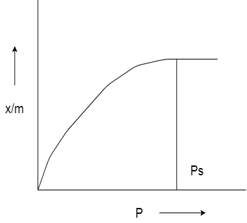
Explanation: The above graph depicts Monolayer adsorption. This graph can be easily explained using Langmuir Adsorption Isotherm. Examples of Type-I adsorption are Adsorption of Nitrogen (N2) or Hydrogen (H) on charcoal at temperature near to -1800C.
6. Calculate the adsorption of a dye on activated carbon at 25oC, where k = 0.025, n = 0.5 and C = 0.04.
Based on the Freundlich isotherm.
a) 0.050
b) 0.030
c) 0.040
d) 0.060
Answer
Answer: c [Reason:] Given data
n = 0.5
Kd = 0.025
C = 0.04
Substitute the values in the corresponding equation
q = Kd C (1/n)
q = (0.025) (0.04)(1/0.5)
q = 0.040.
7. Which of the following statements regarding the physical adsorption of a gas on surface of solid is not correct?
a) On increasing temperature, adsorption increases continuously
b) Enthalpy changes are negative
c) Adsorption is specific
d) It is reversible in nature
Answer
Answer: a [Reason:] Physisorption is exothermic in nature. Therefore according to le chateliars principle, it occurs readily at low temperature and decreases with increase in temperature. Bond between adsorbent i.e. surface and adsorbate like gases are weak so when temperature is increasing the bond get break easily and adsorption of adsorbate get stop so rate will decrease on increasing temperature.
8. Which of the following is not characteristic of chemisorption?
a) It is irreversible
b) It is specific
c) It is multilayer phenomenon
d) Heat of adsorption is about 400kj
Answer
Answer: c [Reason:] Chemisorption involves formation of chemical bonds between adsorbate and adsorbent molecules. Once the valency is satisfied, the adsorbent molecules can’t form bond with more adsorbate molecules. Thus only one layer is formed.
9. For an adsorbant-adsorbate system obeying the Langmuir adsorption isotherm, b = 0.48 bar-1 and p = 0.16 bar-1. At what pressure will 50% of the surface be covered?
a) 0.05 bar
b) 0.07 bar
c) 0.08 bar
d) 0.04 bar
Answer
Answer: b [Reason:] Given data
b = 0.48 bar-1
p = 0.16 bar-1
Substitute in the corresponding equation
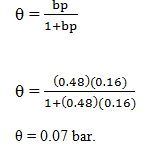
10. Adsorption of methane follows the Langmuir adsorption isotherm at 90K. If p = 1.896cm3g-1bar-1 and b = 0.146bar-1. Calculate the value of θ.
a) 0.116 bar
b) 0.514 bar
c) 0.214 bar
d) 0.216 bar
Answer
Answer: d [Reason:] Given data
p = 1.896cm3g-1 bar-1
b = 0.146 bar-1
Substitute in the corresponding equation
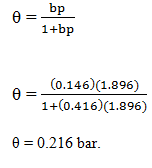
Set 2
1. Glycolysis is an aerobic process.
a) True
b) False
Answer
Answer: b [Reason:] It is an anaerobic process. None of its nine steps involve the use of oxygen. However, immediately upon finishing glycolysis, the cell must continue respiration in either an aerobic or anaerobic direction; this choice is made based on the circumstances of the particular cell.
2. Yeast is only restricted to aerobic fermentation.
a) True
b) False
Answer
Answer: b [Reason:] Yeast can use any of three major metabolic modes: aerobic fermentation in the presence of sugar and oxygen, anaerobic fermentation in the presence of sugar but absence of oxygen, and respiration (necessarily aerobic) in the presence of oxygen and a low concentration of fermentable sugar.
3. How much NADH is produced in the citric acid cycle?
a) One
b) Three
c) Six
d) Two
Answer
Answer: c [Reason:] Products of the first turn of the cycle are one GTP (or ATP), three NADH, one QH2, and two CO2. Because two acetyl-CoA molecules are produced from each glucose molecule, two cycles are required per glucose molecule. Therefore, at the end of two cycles, the products are: two GTP, six NADH, two QH2, and four CO2.
4. How much ATP is produced in the citric acid cycle?
a) 32
b) 34
c) 36
d) 38
Answer
Answer: d [Reason:] A total of 10 NADH’s is made (in glucolysis and the Krebs cycle) per glucose, and 2 FADH2’s. We generally say that you get 3 ATPs per NADH and 2 per FADH2, so that these carriers produce a total of 30+4 = 34 ATPs and the Krebs cycle itself produces 2 GTPs, which are equivalent to 2 more ATPs, for a total of 38.
5. Citric acid is a weak organic acid.
a) True
b) False
Answer
Answer: a [Reason:] Citric Acid is a naturally occurring preservative used in many applications including canning, flavoring, cleaning, and even photography development. As a weak organic acid, it is commonly purchased in powder form, but is found in all citrus fruits including lemons, limes, oranges, and tangerines.
6. Which of the following is a metal salt of citric acid used to prevent blood clot?
a) Trimagnesium citrate
b) Trisodium citrate
c) Dimagnesium citrate
d) Bisodium citrate
Answer
Answer: b [Reason:] Metal salts of citric acid such as trisodium citrate are used to prevent blood clotting by complexing calcium. Trisodium citrate can be used in detergents and cleaners as a cleaning agent instead of phosphates.
7. What do you mean by surface fermentation?
a) Fermentation on semi-solid media
b) Fermentation on liquid media
c) Fermentation on liquid surface
d) Fermentation on solid media
Answer
Answer: d [Reason:] The oldest and a relatively simple method for production of complex flavour extracts is the fermentation of flavour raw materials by bacteria and moulds (aspergillus, mucor) on solid nutrient media. The media is placed in simple thermostatic boxes on baking-tray like plates to which the micro-organisms are inoculated.
8. What do you mean by submerged fermentation?
a) Fermentation on semi-solid media
b) Fermentation on liquid media
c) Fermentation on semi-solid surface
d) Fermentation on solid media
Answer
Answer: b [Reason:] Submerged fermentation is generally applicable for the manufacturing of cell products by propagation of micro-organisms and cell cultures in a fluid nutrient media.
9. Saccharomyces translation means:
a) Non-sugar Fungus
b) Non-sugar yeast
c) Sugar fungus
d) Sugar bacteria
Answer
Answer: c [Reason:] Scientific name: Saccharomyces cerevisiae. Common name: Brewer’s yeast/ Baker’s yeast. Habitat: Saccharomyces when translated means “sugar fungus”. That is what this yeast uses for food. They are found in the wild growing on the skins of grapes and other fruits.
10. The crabtree effect is the repression of respiration.
a) True
b) False
Answer
Answer: a [Reason:] The Crabtree effect describes the phenomenon whereby the yeast, Saccharomyces cerevisiae, produces ethanol(alcohol) in aerobic conditions and high external glucose concentrations rather than producing biomass via the tricarboxylic acid (TCA) cycle, the usual process occurring aerobically in most yeasts. The crabtree effect works by repressing respiration by the fermentation pathway, dependent on the substrate. The occurrence of alcoholic fermentation is not primarily due to a limited respiratory capacity.
11. Which type of drier is widely used for the production of dry yeast?
a) Spray driers
b) Roto–Louvre drier
c) Fluidized bed drier
d) Simple drier
Answer
Answer: a [Reason:] Spray driers are the most widely used. A suspension with 10–20% yeast is atomized into a drying chamber and dried with hot air. The drying temperature and time are 50°C and 10–20 min, respectively.
12. Penicillin production occurs in which growth phase?
a) Lag phase
b) Log phase
c) Stationary phase
d) Death phase
Answer
Answer: c [Reason:] Like all antibiotics, Penicillin is a secondary metabolite, so is only produced in the stationary phase as Bacteria produce secondary metabolite such as Antibiotics after the active stage (log phase) of the growth cycle.
13. Which sort of Fermenter is used for production of Penicillin?
a) Batch Fermenter, Fed-Batch Process
b) Fed-Batch Fermenter, Fed-Batch Process
c) Continuous Batch Fermenter , Fed-Batch Process
d) Fed-Batch Fermenter, Batch process
Answer
Answer: a [Reason:] For Large production of Penicillin a Batch Fermenter, and a Fed-Batch Process is normally used to prolong the stationary period and so as to increase the production of Penicillin and Batch is used over continuous fermenter for large scale production and fed-batch process is used to overcome its disadvantages.
14. What do you mean by liquefaction?
a) Conversion of liquid to solid
b) Conversion of liquid to gas
c) Conversion of solid to liquid
d) Conversion of liquid to semi-liquid
Answer
Answer: c [Reason:] Liquefaction is a process that generates a liquid from a solid or a gas or that generates a non-liquid phase which behaves in accordance with fluid dynamics. It occurs both naturally and artificially.
15. Glucose and corn syrup is the same thing in accordance to sweeteners.
a) True
b) False
Answer
Answer: b [Reason:] Both products are made from corn starch, but regular corn syrup is 100 percent glucose, while high-fructose corn syrup (HFCS) has had some of its glucose converted to fructose enzymatically.
Set 3
1. Ethanol is fermented from which type of source?
a) Fat
b) Lipids
c) Starch
d) Fiber
Answer
Answer: c [Reason:] Ethanol can be fermented from many sources of starch, including corn, wheat, grain sorghum, barley, and potatoes, and from sugar crops such as sugar cane and sweet sorghum. Because there has been has been an abundant supply of corn, most of the ethanol made in the United States is from corn.
2. Ethanol is an electrolytic solution.
a) True
b) False
Answer
Answer: b [Reason:] It is important to realize that a compound may dissolve in water (soluble) but not dissociate into ions. Such compounds do not form ions and thus do not produce electrolytic solutions. They are called non-electrolytes. Examples of non-electrolytes include sugar and ethanol.
3. Saccharomyces translation means_________
a) Non-sugar Fungus
b) Non-sugar yeast
c) Sugar fungus
d) Sugar bacteria
Answer
Answer: c [Reason:] Scientific name: Saccharomyces cerevisiae. Common name: Brewer’s yeast/ Baker’s yeast. Habitat: Saccharomyces when translated means “sugar fungus”. That is what this yeast uses for food. They are found in the wild growing on the skins of grapes and other fruits.
4. Fructose is a hexose sugar.
a) True
b) False
Answer
Answer: a [Reason:] Hexose. Any of various simple sugars, such as glucose and fructose that have six carbon atoms per molecule. Any of various simple sugars (monosaccharides), such as glucose and fructose that have six carbon atoms per molecule.
5. Zymomonas mobilis is __________
a) Facultative aerobe
b) Facultative anaerobe
c) Non- facultative aerobe
d) Non-facultative aerobe
Answer
Answer: b [Reason:] Zymomonas mobilis is a Gram negative, facultative anaerobic, non-sporulating, polarly-flagellated, rod-shaped bacterium. It is the only species found in the genus Zymomonas. It has notable bioethanol-producing capabilities, which surpass yeast in some aspects.
6. What is Whey?
a) A crop
b) A wheat
c) Liquid of milk curdled
d) Soy protein
Answer
Answer: c [Reason:] Whey is the liquid remaining after milk has been curdled and strained. It is a byproduct of the manufacture of cheese or casein and has several commercial uses. Sweet whey is a byproduct produced during the manufacture of rennet types of hard cheese, like Cheddar or Swiss cheese. Acid whey (also known as sour whey) is a byproduct produced during the making of acid types of dairy products, such as cottage cheese or strained yogurt.
7. Anaerobic respiration and anaerobic fermentation are same.
a) True
b) False
Answer
Answer: b [Reason:] Even though fermentation happens without oxygen, it is not the same as anaerobic respiration. Anaerobic respiration begins the same way as aerobic respiration and fermentation. The first step is still glycolysis and it still creates 2 ATP from one carbohydrate molecule.
8. What do you mean by Saccharified?
a) Joining of sugars
b) Joining of fats
c) Breaking of fats
d) Breaking of carbohydrates
Answer
Answer: d [Reason:] Saccharification. : The process of breaking a complex carbohydrate (as starch) into simple sugars.
9. Continuous operation is better than Batch operation in ethanol fermentation.
a) True
b) False
Answer
Answer: a [Reason:] Continuous operation in ethanol fermentations has significant advantages over batch operation. With continuous media sterilization and aseptic operation techniques, contamination problems associated with continuous operation can be eliminated.
10. What do you mean by Homolactic fermentation?
a) Homogenous environment
b) Heterogenous environment
c) Single acid production
d) Two similar acid production
Answer
Answer: c [Reason:] Homolactic fermentation- Any form of fermentation that produces a single acid, but especially the anaerobic conversion of pyruvic acid into lactic acid with concomitant oxidation of NADH to NAD.
11. Which of the following condition is correct according to lactic acid fermentation?
a) Both Low temperature and pH
b) Both High temperature and pH
c) Low temperature and high pH
d) High temperature and low pH
Answer
Answer: d [Reason:] Industrially important homolactics grow at temperatures above 40°C and pH between 5 and 7. High temperature and low pH (pH < 6) reduce the risk of contamination.
12. Ethanol is better than butanol as fuel additive.
a) True
b) False
Answer
Answer: b [Reason:] Butanol is a better fuel additive than ethanol because of its low vapor pressure, low solubility with water, and complete solubility with diesel fuel.
13. Amylolytic is ___________
a) Conversion of starch into sugar
b) Conversion of sugar into starch
c) Hydrolysis of sugar
d) Breakdown of sugar
Answer
Answer: a [Reason:] Amylolytic process or amylolysis is the conversion of starch into sugar by the action of acids or enzymes such as amylase.
14. Saccharolysis is _________
a) Conversion of starch into sugar
b) Conversion of sugar into starch
c) Hydrolysis of sugar
d) Breakdown of sugar
Answer
Answer: c [Reason:] Saccharolytic is capable of hydrolyzing or otherwise metabolizing a sugar molecule resulting in the production of energy.
15. Lignincellulose is a part of woody material.
a) True
b) False
Answer
Answer: a [Reason:] The woody material that gives plants their rigidity and structure comprises three main types of carbon-based polymer — cellulose, hemicellulose and lignin — collectively called lignocellulosic biomass. When taken apart, these polymers yield chemical components that can be used to make biofuels. It is a complex of lignin and cellulose present in the cell walls of woody plants.
Set 4
1.”High energy input for downstream processing is maximized”, is this statement correct or not?
a) True
b) False
Answer
Answer: b [Reason:] Energy input for downstream processing is minimised to avoid damaging heat-labile products. Nevertheless, energy effects are important because biological catalysts are very sensitive to heat and changes in temperature. In large-scale processes, heat released during reaction can cause cell death or denaturation of enzymes if it is not quickly removed.
2. Which of the following is not an intensive property?
a) Temperature
b) Density
c) Mass
d) Mole fraction
Answer
Answer: c [Reason:] Temperature, density, and mole fraction are examples of properties which are independent of the size of the system; these quantities are called intensive variables. On the other hand, mass, volume and energy are extensive variables which change if mass is added to or removed from the system.
3. How much heat is produced by a human body?
a) 200 W
b) 100 W
c) 50 W
d) 0.5 W
Answer
Answer: b [Reason:] A man doing no or very little physical work needs about 2,000 kcal (or less) of energy in his daily food. The body converts this energy almost entirely into heat.
1 day = 24 x 60 x 60 s = 86,400 s 1 cal = 4.2 J
Hence, 2000 kcal/day = 2000 × 4.2 kj/day = (8.4 Mj)/86600s
= 100 j/s = 100 W
We see that a human body doing no work is equivalent to a heat source of about 100 W – the equivalent of a good bulb.
4. 1 watt is equal to how much horsepower (hp) unit?
a) 0.001341 hp
b) 0.001241 hp
c) 0.001141 hp
d) 0.001151 hp
Answer
Answer: a [Reason:] 1 watt = 1 W= 1 J/1 s = 10-3 kW = 10-6 MW
= 3.412 BTU/h
= 0.001341 hp (horsepower units).
5. An automobile has a horsepower rating (power) of 100 hp. Calculate its power in watts.
a) 75.5 kW
b) 74.5 kW
c) 75.4 kW
d) 74.4 kW
Answer
Answer: b [Reason:] 
6. Given the following information about a system, calculate specific enthalpy (in Btu/lbm).

a) 629.6 btu/lbm
b) 639.6 btu/lbm
c) 660.9 btu/lbm
d) 640.9 btu/lbm
Answer
Answer: a [Reason:] h= u + Pv
h = 600 Btu/lbm + (100 lbf/(in2) ) (1.6 〖ft〗^3/lbm ) ((144 in ^2)/(ft^2)) (Btu/( 778 ft-lbf)) = 629.6 btu/lbm.
7. At what rate per hour does a 1 kW heater convert electrical energy into heat?
a) 3.5 MJ
b) 2.5 MJ
c) 3.6 MJ
d) 2.6 MJ
Answer
Answer: c [Reason:] Energy = power x time
1 kW is 1,000 watts
Since 1 watt is 1 joule per sec
1,000 watts is 1,000 joules per sec
In one hour there are 3,600 seconds
Substituting in the equation energy = 1,000 x 3,600 joules
= 3,600,000 joules
= 3.6 MJ
Therefore a 1 kW heater converts 3.6 MJ of electrical energy into heat per hour.
8. Water flows between two points 1, 2. The volumetric flow rate is 20 litres/min. Point 2 is 50 m higher than point 1. The pipe internal diameters are 0.5 cm at point 1 and 1 cm at point 2. The pressure at point 2 is 1 atm. Calculate the pressure at point 1.
a) 4.6 bar
b) 5.6 bar
c) 4.1 bar
d) 5.1 bar
Answer
Answer: a [Reason:] ΔP/ρ + Δv2/2 + gΔh +F = W
ΔP = P2 – P1 (Pa)
Δv2 = v22 – v12
Δh = h2 – h1 (m)
F= frictional energy loss (mechanical energy loss to system) (J/kg)
W = work done on system by pump (J/kg)
ρ = 1000 kg/m3
Volumetric flow is 20/ (1000.60) m3/s
= 0.000333 m3/s
v1 = 0.000333/(π(0.0025)2) = 16.97 m/s
v2 = 0.000333/ (π(0.005)2) = 4.24 m/s
(101325 – P1)/1000 + [(4.24)2 – (16.97)2]/2 + 9.81.50 = 0
P1 = 456825 Pa (4.6 bar).
9. Determine the density, specific gravity, and mass of the air in a room whose dimensions are 4m × 5m × 6m at 100 kPa and 25° C.
a) 1.16 kg/ m3, 0.00116, 140 kg
b) 1.17 kg/ m3, 0.00117, 140 kg
c) 1.15 kg/ m3, 0.00115, 140 kg
d) 1.14 kg/ m3, 0.00114, 140 kg
Answer
Answer: b [Reason:] At specified conditions, air can be treated as ideal gas.
The gas constant of air is R = 0.287 k Pa- m3/ Kg K
The density of the air is determined from the ideal-gas relation , P = ρ R T to be
ρ = P/RT = (100 kPa)/((0.287 k Pa-m3/Kg K) ( 25+273.15)K) = 1.17 kg/ m3
Then the specific gravity of the air becomes
SG = ( ρ )/ρH2O = (1.17 kg/ m3)/(1000 kg/m3) = 0.00117
Finally, the volume and mass of the air in the room are
V = (4m) (5m) (6m) = 120 m3
m = ρV = (1.17 kg/ m3) (120 m3) = 140 kg.
10. “Extensive properties are linearly dependent on the amount of substance.” Is this statement true or false?
a) True
b) False
Answer
Answer: a [Reason:] Extensive properties are linearly dependent on the amount of substance. Examples: mass, volume, energy. Take two identical samples with all properties identical and combine them into a single sample. Properties that double are extensive. Properties that remain the same are intensive. For example, if I took 1.0 liter of water at room temperature (25 °C) and added another 1.0 liter of water at the same temperature then I would have 2.0 liters of water at 25 °C. From this example we see that Volume and Mass are extensive properties (i.e., volume and mass doubled), while Temperature is an intensive property (i.e., temperature stayed the same). You would also expect the density to remain the same, so it is also an intensive property.
Set 5
1. Which type of catalysis reaction defines cell growth?
a) Tandem catalysis
b) Surface catalysis
c) Homo catalysis
d) Autocatalysis
Answer
Answer: d [Reason:] Cell growth is an autocatalytic reaction: this means that the catalyst is a product of the reaction. The performance of catalytic reactions is characterized by variables such as the reaction rate and yield of product from substrate. In bioreactors, the growth is autocatalytic in that the more cells you have, the greater the growth rate.
2. According to reaction theory, Reaction kinetics is concerned with how far the reaction can proceed.
a) True
b) False
Answer
Answer: b [Reason:] Reaction theory has two fundamental parts: reaction thermodynamics and reaction kinetics. Reaction thermodynamics is concerned with how far the reaction can proceed; no matter how fast a reaction is, it cannot continue beyond the point of chemical equilibrium. On the other hand, reaction kinetics is concerned with the rate at which reactions proceed.
3. The equilibrium constant (K) depends on __________
a) Pressure
b) pH
c) Temperature
d) Density
Answer
Answer: c [Reason:] The value of K depends on temperature as follows:

where, ∆Grxn° is the change in standard free energy per mole of A reacted, R is the ideal gas constant and T is absolute temperature.
4. For exothermic reactions, which condition is applicable for equilibrium constant K?
a) K decreases with increasing temperature
b) K decreases with decreasing temperature
c) Positive ΔHrxn° with increasing temperature; K increases
d) Negative ΔHrxn° with increasing temperature; K increases
Answer
Answer: a [Reason:] For exothermic reactions with negative ΔHrxn°, K decreases with increasing temperature. For endothermic reactions and positive ΔHrxn° , K increases with temperature.
5. Glucose isomerase is used extensively in the USA for production of high-fructose syrup. The reaction is ___________
Glucose ⇄ Fructose
ΔHrxn° for this reaction is 5.73 kJ gmol-l; ΔS_rxn^° is 0.0176 kJ gmol-l K-l.
Calculate the equilibrium constants at 50℃. (Given R = 8.3144J gmol-l K-l =8.3144×10-3 kJ gmol-lK-l).
a) 0.95
b) 0.94
c) 0.96
d) 0.98
Answer
Answer: d
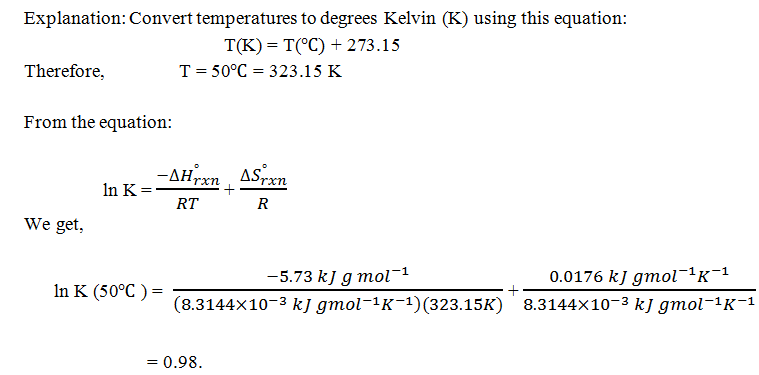
6. Refer to Q5 and, calculate the same for equilibrium constant at 75℃.
a) 1.15
b) 1.16
c) 1.18
d) 1.17
Answer
Answer: a [Reason:] T = 75℃ = 348.15 K
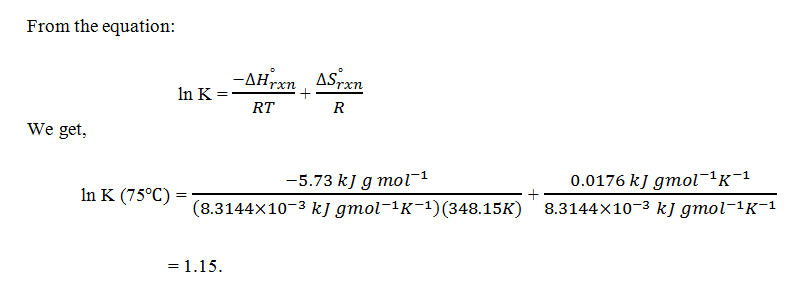
7. Refer to Q5 and Q6, and estimate that whether 75℃ is desirable to operate?
a) True
b) False
Answer
Answer: a [Reason:] K in 50℃ is 0.98 and K in 75℃ is 1.15.As K increases, the fraction of fructose in the equilibrium mixture increases. Therefore, from an equilibrium point of view, it is more desirable to operate the reactor at 75℃. However, other factors such as enzyme deactivation at high temperatures should also be considered.
8. Which of the following is not a reversible reaction?
a) Formation of NH3 rate
b) Decomposition of NH3 rate
c) Decomposition of potassium chlorate
d) Reaction of gaseous hydrogen with iodine vapors
Answer
Answer: c [Reason:] Chemical reactions in which the products thus formed during a chemical change do not combine and produce back the reactants are better known as irreversible reactions. Decomposition of potassium chlorate into potassium chloride and oxygen after heating.
![]()
In the above reaction however, the products are not combining to form back the potassium chlorate. In case of physical and chemical processes which are irreversible in nature, the changes are found to be uni direction and the processes is completed.
9. The irreversible reaction takes place in the closed vessel.
a) True
b) False
Answer
Answer: b [Reason:] For irreversible reaction Gibbs free energy change will be less than zero ΔG < 0 is the condition for the irreversible reaction. Irreversible reaction normally takes place in an open vessel.
10. What is the unit of the reaction yield?
a) gmol gmol
b) gmol2
c) gmolK-2
d) gmol/ gmol
Answer
Answer: d [Reason:] The theoretical yield is the amount predicted by a stoichiometric calculation based on the number of moles of all reactants present. This calculation assumes that only one reaction occurs and that the limiting reactant reacts completely.
11. “The rate per quantity of enzyme or cells involved in the reaction”, this is applicable to which type of reaction rate?
a) Total rate
b) Specific rate
c) Variable rate
d) Volumetric rate
Answer
Answer: b [Reason:] In specific rate, biological reactions involve enzyme and cell catalysts. Because the total rate of conversion depends on the amount of catalyst present, it is sometimes useful to specify reaction rate as the rate per quantity of enzyme or cells involved in the reaction.
12. How do we measure the concentration of the enzyme?
a) In units of mass
b) In units of time
c) In units of activity
d) In units of volume
Answer
Answer: c [Reason:] The mass of a particular enzyme added to a reaction is rarely known; most commercial enzyme preparations contain several components in unknown and variable proportions depending on the batch obtained from the manufacturer. To overcome these difficulties, enzyme quantity is often expressed as units of activity measured under specified conditions. One unit of enzyme is usually taken as the amount which catalyses conversion of 1μmol substrate per minute at the optimal temperature, pH and substrate concentration.
13. Total, volumetric and specific productivities are different.
a) True
b) False
Answer
Answer: b [Reason:] Total, volumetric and specific productivities are interrelated concepts in process design. For example, high total productivity could be achieved with a catalyst of low specific activity if the reactor is loaded with a high catalyst concentration. If this is not possible, the volumetric productivity will be relatively low and a larger reactor is required to achieve the desired total productivity.
14. The conditions of rate of reaction from the following is _______
a) Reactions proceeds with the increase of reactants
b) Reactions decrease with the decrease of reactants
c) Reactions increase with decrease in temperature
d) Reactions increase with increase in temperature
Answer
Answer: d [Reason:] As reactions proceed, the concentrations of reactants decrease. In general, rate of reaction depends on reactant concentration so that the specific rate of conversion decreases simultaneously. Reaction rate also varies with temperature; most reactions speed up considerably as the temperature rises.
15. Variation of the rate constant k with temperature is described by which equation?
a) Arrhenius equation
b) Monod equation
c) Kirchoff’s equation
d) Newton’s second law of thermodynamics
Answer
Answer: a [Reason:] Temperature has a significant kinetic effect on reactions. Variation of the rate constant k with temperature is described by the Arrhenius equation:
k = A e-E/RT
Where, k is the rate constant, A is the Arrhenius constant or frequency factor, E is the activation energy for the reaction, R is the ideal gas constant, and T is absolute temperature. According to the Arrhenius equation, as T increases, k increases exponentially.
Taking the natural logarithm of both sides of equation:

Thus, a plot of ln k versus 1/T gives a straight line with slope -E/R . For many reactions the value of E is positive and large, indicating a rapid increase in reaction rate with temperature.
Total Views: 21
